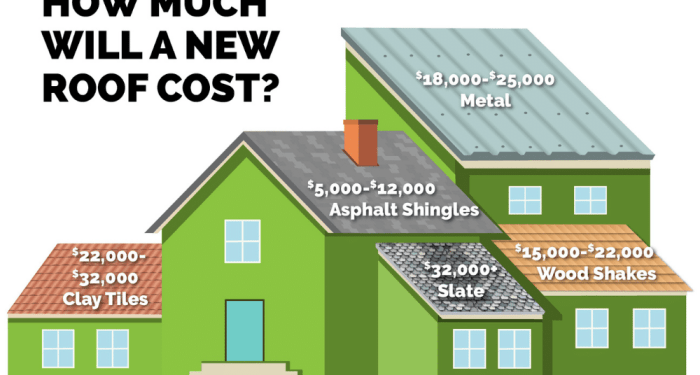Delving into the world of roof replacement cost estimates, this comprehensive guide covers the key factors, calculation methods, challenges, and tips to help you navigate through the process with ease.
.
Factors influencing roof replacement cost estimate
When it comes to estimating the cost of replacing a roof, several key factors come into play that can significantly impact the overall cost. Understanding these factors can help homeowners make informed decisions and plan their budget accordingly.Material Type
The type of roofing material chosen for the replacement can have a major impact on the cost estimate. For example, asphalt shingles are typically more affordable compared to materials like metal or slate. The quality and durability of the material also play a role in determining the overall cost.Roof Size and Pitch
The size and pitch of the roof are important factors to consider when estimating the cost of replacement. A larger roof with a steep pitch will require more materials and labor, leading to a higher cost. Additionally, the complexity of the roof design can also affect the estimate.Labor Costs
Labor costs for roof replacement can vary depending on the location, complexity of the job, and the experience of the roofing contractor. Highly skilled labor may come at a higher price, but it can ensure quality workmanship and a longer-lasting roof.Additional Services
Additional services such as removing the old roof, repairing underlying damage, or installing new insulation can add to the overall cost estimate. These services are essential for ensuring the longevity and functionality of the new roof but can contribute to the total cost.Local Regulations and Permits
Local regulations and permits required for roof replacement can also impact the cost estimate. Obtaining permits and ensuring compliance with building codes may add to the overall expenses but are necessary for a legal and safe roof replacement.Warranty and Maintenance
Opting for warranties on materials and workmanship, as well as investing in regular maintenance services, can affect the cost estimate. While these additions may increase the upfront cost, they can provide long-term benefits and peace of mind for homeowners.Methods for calculating roof replacement cost estimate
Calculating the cost estimate for roof replacement involves various methods employed by professionals. These methods differ in accuracy and reliability, each with its own step-by-step process.1. Square Footage Method
The square footage method is a common approach used by roofing professionals to calculate the cost of replacing a roof. This method involves determining the total square footage of the roof and multiplying it by the cost per square foot for the chosen roofing material. The formula for this method can be expressed as:Total Cost = Total Square Footage x Cost per Square Foot
2. Roofing Material and Labor Costs
Another method used is to estimate the cost of roofing materials and labor separately. Professionals will calculate the cost of materials based on the type of roofing material chosen and the required quantity. Labor costs are then added based on the complexity of the job and the time required for installation.3. Roof Pitch and Complexity
The pitch and complexity of a roof can significantly impact the cost estimate. Steeper roofs or roofs with intricate designs may require additional materials, labor, and time, resulting in a higher overall cost. Professionals take these factors into account when providing an estimate4. Additional Factors
In addition to the above methods, professionals may consider other factors such as removal of old roofing materials, disposal costs, permits, and any necessary repairs or upgrades. These additional factors are included in the cost estimate to provide a comprehensive overview of the expenses involved.Common challenges in accurately estimating roof replacement costs
Estimating roof replacement costs can be a complex task, with various challenges that can affect the accuracy of the final estimate. These challenges often stem from the unique characteristics of each roof and the factors that influence the cost of replacement.Varying material costs
One of the common challenges in estimating roof replacement costs is the fluctuating prices of roofing materials. The cost of materials can vary based on factors such as market demand, availability, and the quality of the materials. To overcome this challenge, it is essential to stay updated on the current market prices and factor in potential price changes when estimating the cost.Hidden damages
Another challenge is the presence of hidden damages that may not be visible during the initial inspection. These damages, such as rot or mold, can significantly impact the overall cost of roof replacement. To address this challenge, it is crucial to conduct a thorough inspection and consider the possibility of unforeseen damages when calculating the estimate.Labor costs
Labor costs are another factor that can pose a challenge in accurately estimating roof replacement costs. The cost of labor can vary depending on the complexity of the job, the location, and the experience of the roofing contractors. To improve accuracy, it is important to obtain multiple quotes from reputable contractors and factor in the labor costs accordingly.Unforeseen circumstances
Unforeseen circumstances, such as adverse weather conditions or unexpected structural issues, can also impact the initial estimate of roof replacement costs. To mitigate this challenge, it is advisable to set aside a contingency fund to account for any unexpected expenses that may arise during the roof replacement process.Tips for obtaining an accurate roof replacement cost estimate
When it comes to getting an accurate estimate for your roof replacement cost, there are several tips that homeowners can follow to ensure they are well-informed and prepared. Effective communication with contractors and including contingency plans are crucial aspects of this process.Communicate effectively with contractors
- Be clear about your expectations and requirements from the beginning.
- Provide detailed information about the current state of your roof and any specific preferences you may have.
- Ask questions to clarify any uncertainties and ensure that both parties are on the same page.
- Request a written breakdown of the estimate to understand the cost of materials, labor, and any additional charges.
Include contingency plans in the cost estimate
- Consider unexpected issues that may arise during the roof replacement process, such as structural damage or hidden problems.
- Allocate a percentage of the total estimate as a contingency fund to cover unforeseen expenses.
- Discuss with your contractor the possibility of additional costs and establish a plan for addressing them if they occur.
















